Feedback in Communication: Reflective Essay Using Gibbs Model
VerifiedAdded on 2023/04/12
|7
|1254
|108
Essay
AI Summary
This essay is a reflective analysis of feedback in communication, utilizing Gibbs' reflective cycle (description, feelings, evaluation, analysis, conclusion, and action plan). The author explores the vital role of feedback, both positive and negative, in personal and professional development. Description involves understanding the context of messages, while feelings encompass emotional awareness before, during, and after events. Evaluation assesses the quality of experiences, and analysis identifies problems encountered. The conclusion focuses on alternative actions for future scenarios, and the action plan outlines future responses based on past experiences. The essay also touches upon the link between effective feedback and social work ethics, highlighting the importance of honesty, trust, and healthy relationships. Ultimately, the author emphasizes that understanding context, evaluating experiences, and analyzing problems are crucial for providing optimal feedback and improving communication skills.
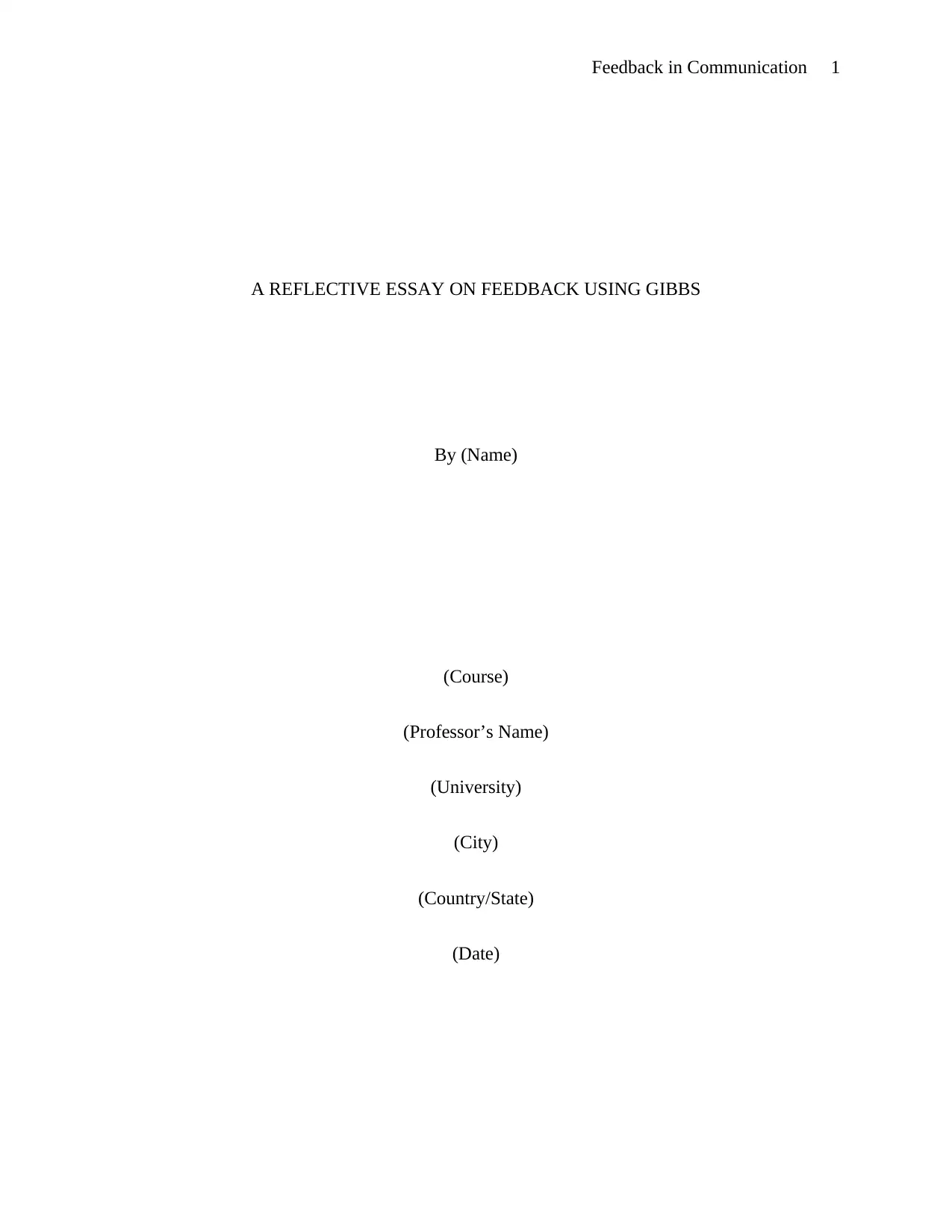
Feedback in Communication 1
A REFLECTIVE ESSAY ON FEEDBACK USING GIBBS
By (Name)
(Course)
(Professor’s Name)
(University)
(City)
(Country/State)
(Date)
A REFLECTIVE ESSAY ON FEEDBACK USING GIBBS
By (Name)
(Course)
(Professor’s Name)
(University)
(City)
(Country/State)
(Date)
Paraphrase This Document
Need a fresh take? Get an instant paraphrase of this document with our AI Paraphraser
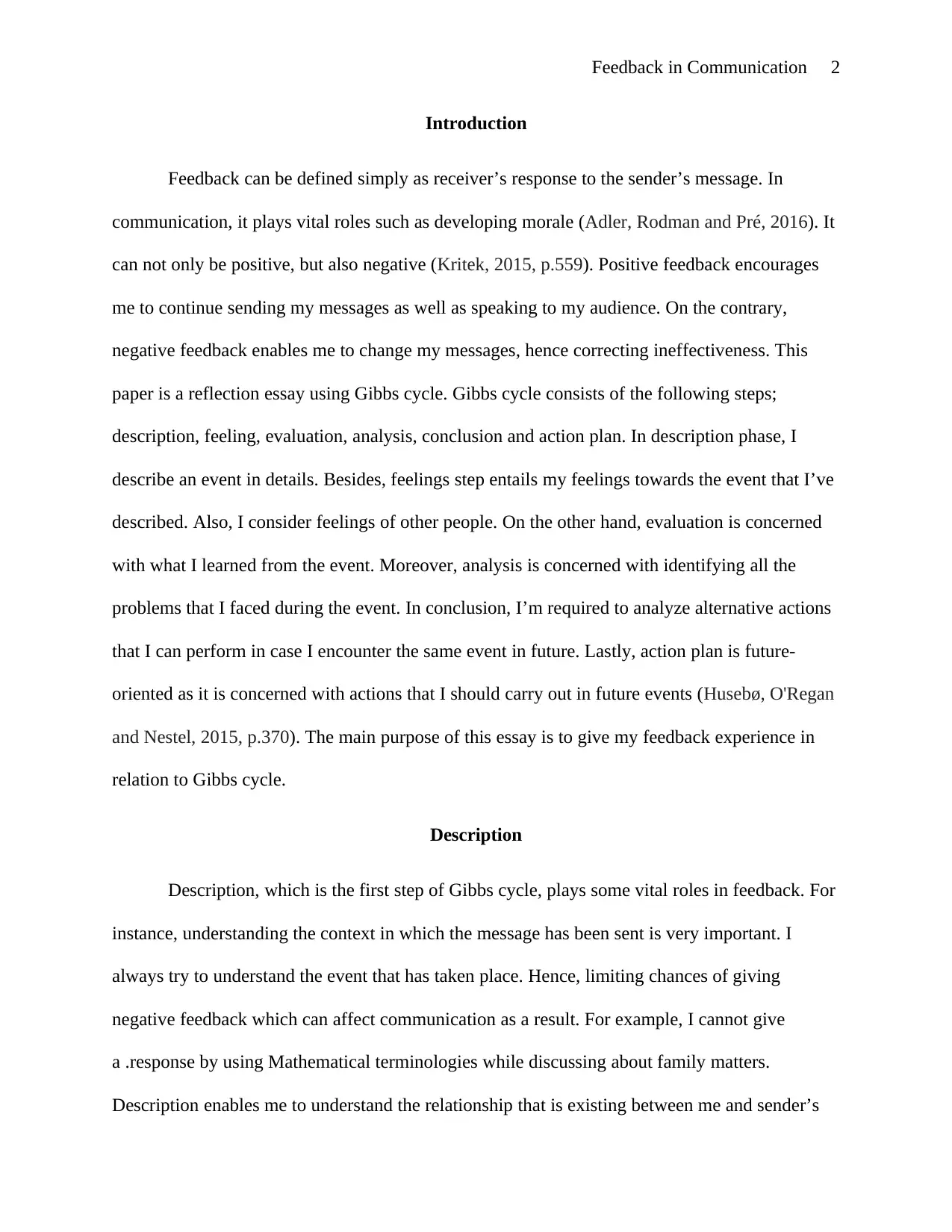
Feedback in Communication 2
Introduction
Feedback can be defined simply as receiver’s response to the sender’s message. In
communication, it plays vital roles such as developing morale (Adler, Rodman and Pré, 2016). It
can not only be positive, but also negative (Kritek, 2015, p.559). Positive feedback encourages
me to continue sending my messages as well as speaking to my audience. On the contrary,
negative feedback enables me to change my messages, hence correcting ineffectiveness. This
paper is a reflection essay using Gibbs cycle. Gibbs cycle consists of the following steps;
description, feeling, evaluation, analysis, conclusion and action plan. In description phase, I
describe an event in details. Besides, feelings step entails my feelings towards the event that I’ve
described. Also, I consider feelings of other people. On the other hand, evaluation is concerned
with what I learned from the event. Moreover, analysis is concerned with identifying all the
problems that I faced during the event. In conclusion, I’m required to analyze alternative actions
that I can perform in case I encounter the same event in future. Lastly, action plan is future-
oriented as it is concerned with actions that I should carry out in future events (Husebø, O'Regan
and Nestel, 2015, p.370). The main purpose of this essay is to give my feedback experience in
relation to Gibbs cycle.
Description
Description, which is the first step of Gibbs cycle, plays some vital roles in feedback. For
instance, understanding the context in which the message has been sent is very important. I
always try to understand the event that has taken place. Hence, limiting chances of giving
negative feedback which can affect communication as a result. For example, I cannot give
a .response by using Mathematical terminologies while discussing about family matters.
Description enables me to understand the relationship that is existing between me and sender’s
Introduction
Feedback can be defined simply as receiver’s response to the sender’s message. In
communication, it plays vital roles such as developing morale (Adler, Rodman and Pré, 2016). It
can not only be positive, but also negative (Kritek, 2015, p.559). Positive feedback encourages
me to continue sending my messages as well as speaking to my audience. On the contrary,
negative feedback enables me to change my messages, hence correcting ineffectiveness. This
paper is a reflection essay using Gibbs cycle. Gibbs cycle consists of the following steps;
description, feeling, evaluation, analysis, conclusion and action plan. In description phase, I
describe an event in details. Besides, feelings step entails my feelings towards the event that I’ve
described. Also, I consider feelings of other people. On the other hand, evaluation is concerned
with what I learned from the event. Moreover, analysis is concerned with identifying all the
problems that I faced during the event. In conclusion, I’m required to analyze alternative actions
that I can perform in case I encounter the same event in future. Lastly, action plan is future-
oriented as it is concerned with actions that I should carry out in future events (Husebø, O'Regan
and Nestel, 2015, p.370). The main purpose of this essay is to give my feedback experience in
relation to Gibbs cycle.
Description
Description, which is the first step of Gibbs cycle, plays some vital roles in feedback. For
instance, understanding the context in which the message has been sent is very important. I
always try to understand the event that has taken place. Hence, limiting chances of giving
negative feedback which can affect communication as a result. For example, I cannot give
a .response by using Mathematical terminologies while discussing about family matters.
Description enables me to understand the relationship that is existing between me and sender’s
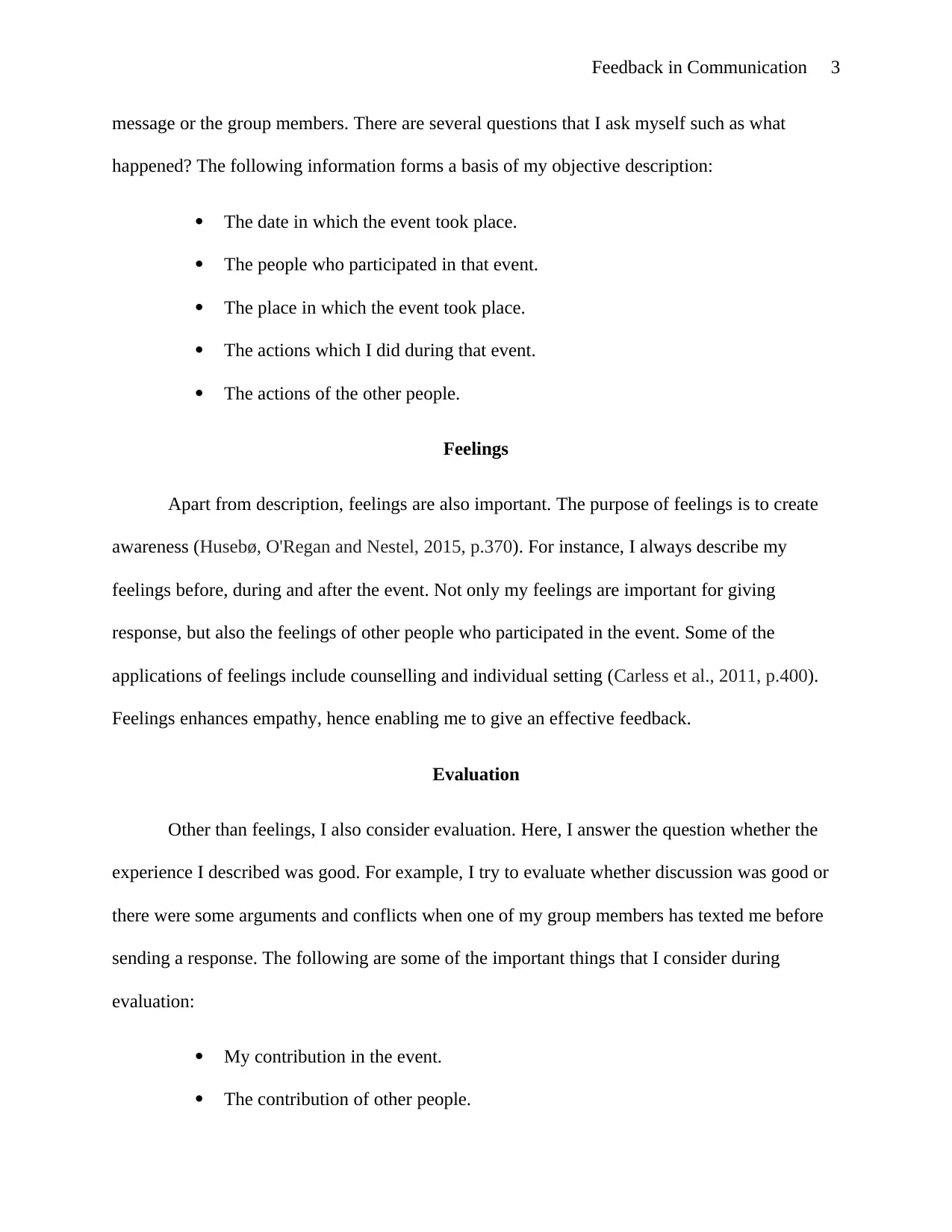
Feedback in Communication 3
message or the group members. There are several questions that I ask myself such as what
happened? The following information forms a basis of my objective description:
The date in which the event took place.
The people who participated in that event.
The place in which the event took place.
The actions which I did during that event.
The actions of the other people.
Feelings
Apart from description, feelings are also important. The purpose of feelings is to create
awareness (Husebø, O'Regan and Nestel, 2015, p.370). For instance, I always describe my
feelings before, during and after the event. Not only my feelings are important for giving
response, but also the feelings of other people who participated in the event. Some of the
applications of feelings include counselling and individual setting (Carless et al., 2011, p.400).
Feelings enhances empathy, hence enabling me to give an effective feedback.
Evaluation
Other than feelings, I also consider evaluation. Here, I answer the question whether the
experience I described was good. For example, I try to evaluate whether discussion was good or
there were some arguments and conflicts when one of my group members has texted me before
sending a response. The following are some of the important things that I consider during
evaluation:
My contribution in the event.
The contribution of other people.
message or the group members. There are several questions that I ask myself such as what
happened? The following information forms a basis of my objective description:
The date in which the event took place.
The people who participated in that event.
The place in which the event took place.
The actions which I did during that event.
The actions of the other people.
Feelings
Apart from description, feelings are also important. The purpose of feelings is to create
awareness (Husebø, O'Regan and Nestel, 2015, p.370). For instance, I always describe my
feelings before, during and after the event. Not only my feelings are important for giving
response, but also the feelings of other people who participated in the event. Some of the
applications of feelings include counselling and individual setting (Carless et al., 2011, p.400).
Feelings enhances empathy, hence enabling me to give an effective feedback.
Evaluation
Other than feelings, I also consider evaluation. Here, I answer the question whether the
experience I described was good. For example, I try to evaluate whether discussion was good or
there were some arguments and conflicts when one of my group members has texted me before
sending a response. The following are some of the important things that I consider during
evaluation:
My contribution in the event.
The contribution of other people.
⊘ This is a preview!⊘
Do you want full access?
Subscribe today to unlock all pages.

Trusted by 1+ million students worldwide
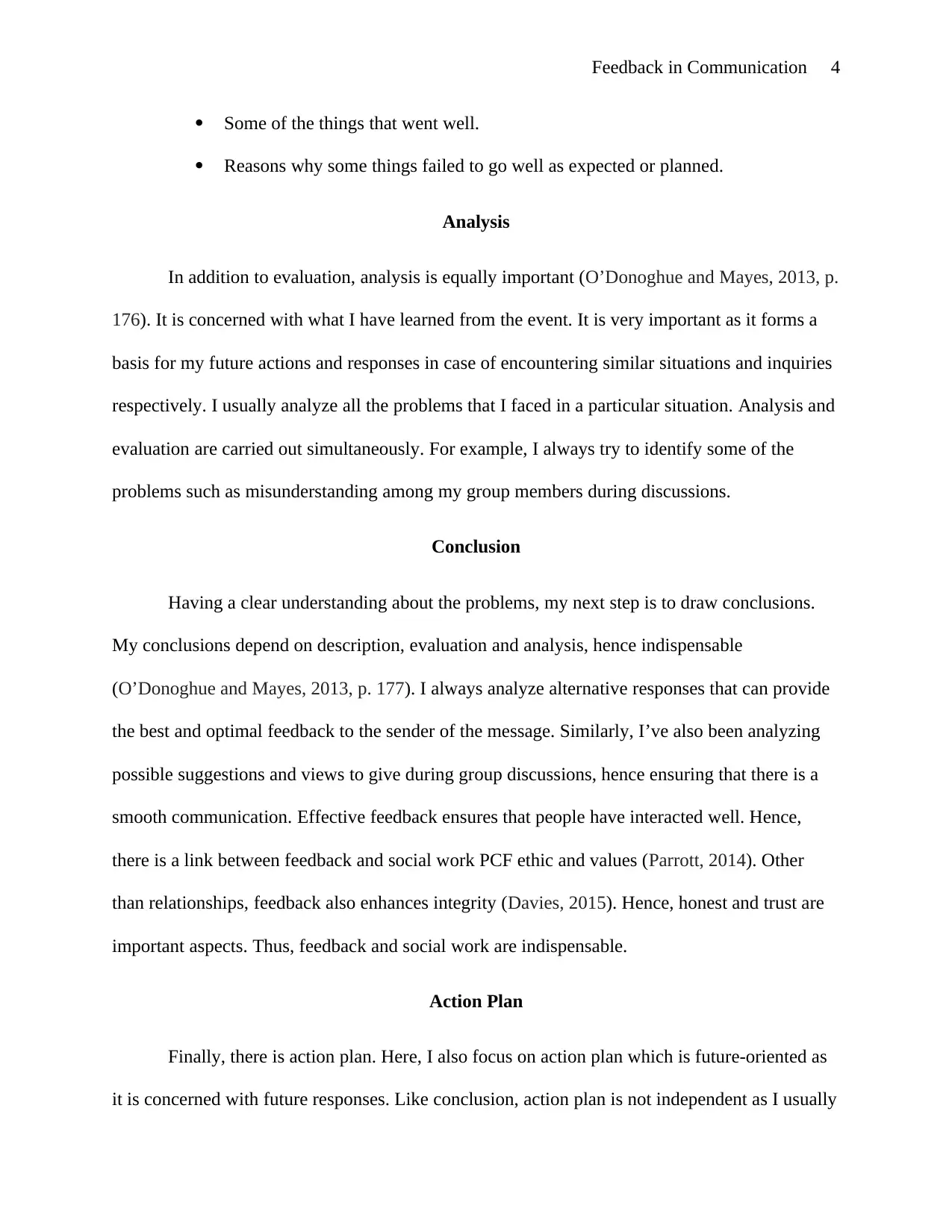
Feedback in Communication 4
Some of the things that went well.
Reasons why some things failed to go well as expected or planned.
Analysis
In addition to evaluation, analysis is equally important (O’Donoghue and Mayes, 2013, p.
176). It is concerned with what I have learned from the event. It is very important as it forms a
basis for my future actions and responses in case of encountering similar situations and inquiries
respectively. I usually analyze all the problems that I faced in a particular situation. Analysis and
evaluation are carried out simultaneously. For example, I always try to identify some of the
problems such as misunderstanding among my group members during discussions.
Conclusion
Having a clear understanding about the problems, my next step is to draw conclusions.
My conclusions depend on description, evaluation and analysis, hence indispensable
(O’Donoghue and Mayes, 2013, p. 177). I always analyze alternative responses that can provide
the best and optimal feedback to the sender of the message. Similarly, I’ve also been analyzing
possible suggestions and views to give during group discussions, hence ensuring that there is a
smooth communication. Effective feedback ensures that people have interacted well. Hence,
there is a link between feedback and social work PCF ethic and values (Parrott, 2014). Other
than relationships, feedback also enhances integrity (Davies, 2015). Hence, honest and trust are
important aspects. Thus, feedback and social work are indispensable.
Action Plan
Finally, there is action plan. Here, I also focus on action plan which is future-oriented as
it is concerned with future responses. Like conclusion, action plan is not independent as I usually
Some of the things that went well.
Reasons why some things failed to go well as expected or planned.
Analysis
In addition to evaluation, analysis is equally important (O’Donoghue and Mayes, 2013, p.
176). It is concerned with what I have learned from the event. It is very important as it forms a
basis for my future actions and responses in case of encountering similar situations and inquiries
respectively. I usually analyze all the problems that I faced in a particular situation. Analysis and
evaluation are carried out simultaneously. For example, I always try to identify some of the
problems such as misunderstanding among my group members during discussions.
Conclusion
Having a clear understanding about the problems, my next step is to draw conclusions.
My conclusions depend on description, evaluation and analysis, hence indispensable
(O’Donoghue and Mayes, 2013, p. 177). I always analyze alternative responses that can provide
the best and optimal feedback to the sender of the message. Similarly, I’ve also been analyzing
possible suggestions and views to give during group discussions, hence ensuring that there is a
smooth communication. Effective feedback ensures that people have interacted well. Hence,
there is a link between feedback and social work PCF ethic and values (Parrott, 2014). Other
than relationships, feedback also enhances integrity (Davies, 2015). Hence, honest and trust are
important aspects. Thus, feedback and social work are indispensable.
Action Plan
Finally, there is action plan. Here, I also focus on action plan which is future-oriented as
it is concerned with future responses. Like conclusion, action plan is not independent as I usually
Paraphrase This Document
Need a fresh take? Get an instant paraphrase of this document with our AI Paraphraser
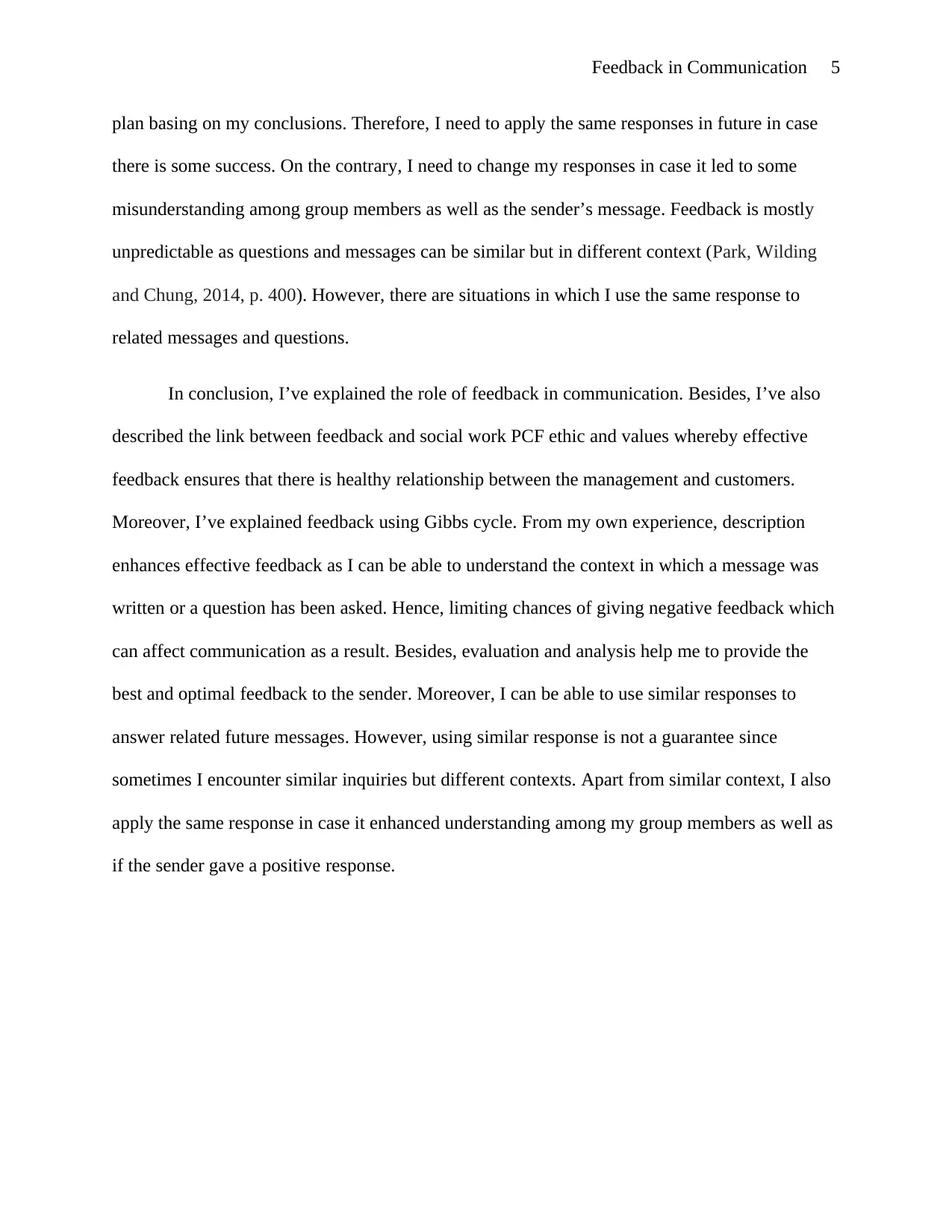
Feedback in Communication 5
plan basing on my conclusions. Therefore, I need to apply the same responses in future in case
there is some success. On the contrary, I need to change my responses in case it led to some
misunderstanding among group members as well as the sender’s message. Feedback is mostly
unpredictable as questions and messages can be similar but in different context (Park, Wilding
and Chung, 2014, p. 400). However, there are situations in which I use the same response to
related messages and questions.
In conclusion, I’ve explained the role of feedback in communication. Besides, I’ve also
described the link between feedback and social work PCF ethic and values whereby effective
feedback ensures that there is healthy relationship between the management and customers.
Moreover, I’ve explained feedback using Gibbs cycle. From my own experience, description
enhances effective feedback as I can be able to understand the context in which a message was
written or a question has been asked. Hence, limiting chances of giving negative feedback which
can affect communication as a result. Besides, evaluation and analysis help me to provide the
best and optimal feedback to the sender. Moreover, I can be able to use similar responses to
answer related future messages. However, using similar response is not a guarantee since
sometimes I encounter similar inquiries but different contexts. Apart from similar context, I also
apply the same response in case it enhanced understanding among my group members as well as
if the sender gave a positive response.
plan basing on my conclusions. Therefore, I need to apply the same responses in future in case
there is some success. On the contrary, I need to change my responses in case it led to some
misunderstanding among group members as well as the sender’s message. Feedback is mostly
unpredictable as questions and messages can be similar but in different context (Park, Wilding
and Chung, 2014, p. 400). However, there are situations in which I use the same response to
related messages and questions.
In conclusion, I’ve explained the role of feedback in communication. Besides, I’ve also
described the link between feedback and social work PCF ethic and values whereby effective
feedback ensures that there is healthy relationship between the management and customers.
Moreover, I’ve explained feedback using Gibbs cycle. From my own experience, description
enhances effective feedback as I can be able to understand the context in which a message was
written or a question has been asked. Hence, limiting chances of giving negative feedback which
can affect communication as a result. Besides, evaluation and analysis help me to provide the
best and optimal feedback to the sender. Moreover, I can be able to use similar responses to
answer related future messages. However, using similar response is not a guarantee since
sometimes I encounter similar inquiries but different contexts. Apart from similar context, I also
apply the same response in case it enhanced understanding among my group members as well as
if the sender gave a positive response.

Feedback in Communication 6
References
Adler, R.B., Rodman, G.R. and Pré, A. D. (2016). Understanding human communication (Vol.
10). Oxford University Press.
Carless, D., Salter, D., Yang, M. and Lam, J. (2011). Developing sustainable feedback
practices. Studies in higher education, 36(4), pp.395-407.
Davies, K. (2015). Skills for social work practice. Macmillan International Higher Education
[Online]. Available from: https://www.macmillanihe.com/page/detail/Skills-for-Social-Work-
Practice/?K=9781137390264 [Accessed 28 March 2019]
Husebø, S.E., O'Regan, S. and Nestel, D. (2015). Reflective practice and its role in
simulation. Clinical Simulation in Nursing, 11(8), pp.368-375 [Online]. Available from:
https://www.sciencedirect.com/science/article/pii/S1876139915000389 [Accessed 28 March
2019]
Kritek, P.A. (2015). Strategies for effective feedback. Annals of the American Thoracic
Society, 12(4), pp.557-560.
O’Donoghue, P. and Mayes, A. (2013). Performance analysis, feedback and communication in
coaching. In Routledge handbook of sports performance analysis (pp. 173-182). Routledge.
Park, C., Wilding, M. and Chung, C. (2014). The importance of feedback: Policy transfer,
translation and the role of communication. Policy Studies, 35(4), pp.397-412.
Parrott, L. (2014). Values and ethics in social work practice. Learning Matters [Online].
Available from: https://www.amazon.com/Values-Ethics-Social-Practice-Transforming/dp/
1844453707 [Accessed 28 March 2019]
References
Adler, R.B., Rodman, G.R. and Pré, A. D. (2016). Understanding human communication (Vol.
10). Oxford University Press.
Carless, D., Salter, D., Yang, M. and Lam, J. (2011). Developing sustainable feedback
practices. Studies in higher education, 36(4), pp.395-407.
Davies, K. (2015). Skills for social work practice. Macmillan International Higher Education
[Online]. Available from: https://www.macmillanihe.com/page/detail/Skills-for-Social-Work-
Practice/?K=9781137390264 [Accessed 28 March 2019]
Husebø, S.E., O'Regan, S. and Nestel, D. (2015). Reflective practice and its role in
simulation. Clinical Simulation in Nursing, 11(8), pp.368-375 [Online]. Available from:
https://www.sciencedirect.com/science/article/pii/S1876139915000389 [Accessed 28 March
2019]
Kritek, P.A. (2015). Strategies for effective feedback. Annals of the American Thoracic
Society, 12(4), pp.557-560.
O’Donoghue, P. and Mayes, A. (2013). Performance analysis, feedback and communication in
coaching. In Routledge handbook of sports performance analysis (pp. 173-182). Routledge.
Park, C., Wilding, M. and Chung, C. (2014). The importance of feedback: Policy transfer,
translation and the role of communication. Policy Studies, 35(4), pp.397-412.
Parrott, L. (2014). Values and ethics in social work practice. Learning Matters [Online].
Available from: https://www.amazon.com/Values-Ethics-Social-Practice-Transforming/dp/
1844453707 [Accessed 28 March 2019]
⊘ This is a preview!⊘
Do you want full access?
Subscribe today to unlock all pages.

Trusted by 1+ million students worldwide

Feedback in Communication 7
1 out of 7
Related Documents
Your All-in-One AI-Powered Toolkit for Academic Success.
+13062052269
info@desklib.com
Available 24*7 on WhatsApp / Email
![[object Object]](/_next/static/media/star-bottom.7253800d.svg)
Unlock your academic potential
Copyright © 2020–2025 A2Z Services. All Rights Reserved. Developed and managed by ZUCOL.





